|
Légion des Voluntaires Français
After the defeat and occupation of France in May 1940, an armistice
was declared in June between the French and German governments.
France was split into two zones. The northern industrial region
of France remained occupied and placed under German administration.
In the southern region of France, a collaborationist government
had established itself in Vichy. 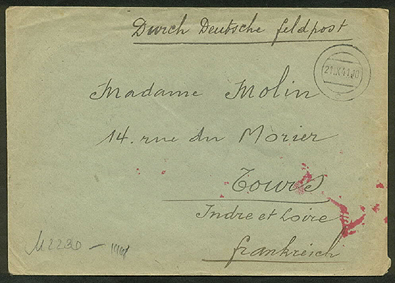
French Legion Feldpost Early legion cover mailed by a volunteer FPN 03865A (1st Btl/1st Co) of the newly formed 638th Infantry Regiment, which was assigned to the German 7th Infantry Division on the Russian Front. Most early covers were required by German postal regulations a written annotation "Durch Deustche Feldpost" (via German military mail). 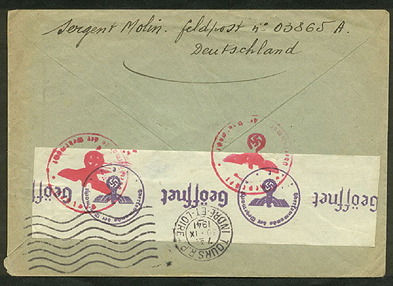
Notice the senders rank Sargent Molin and FPN 03865A. The cover shows sealing tape and censorship markings. | ||||||||||||
|
A total of 5800 Frenchmen were selected into the LVF. They wore
standard German army uniforms and had the French national arm
shield inscribed "FRANCE" placed on their right sleeve. A Colonel
Roger Labonne assumed command of the legion. 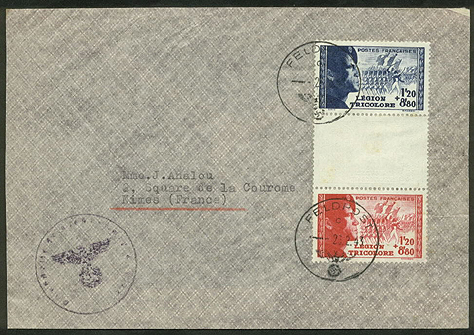
Above is a feldpost cover mailed by volunteer who was in the Debica training barracks. The reverse shows senders FPN 19440 (Staff Training Unit at Debica). Notice the Legion Tricolore stamps attached to the feldpost cover. French Tricolore Legion On 28 June 1942, the
LVF was officially incorporated into the "Legion Tricolore," which was an attempt by the Vichy government to place it into the French armed forces. | ||||||||||||
|
Interesting propaganda postcard commemorating the 2nd Anniversary of the LVF.
| 638th Infantry Regiment The following Feldpost numbers were assigned to the 638th Infantry Regiment Regimental Staff-------------00100 1st. Btl. (1-4 Co.) ------------------- 03865(A-D) 2nd. Btl. (5-8 Co.)------------------- 04358(A-D) 3rd. Btl. (9-12 Co.)------------------- 05492(A-D) 13th. Co.(Light Artillery)-------- Unkown Heavy Weapons---------------- 01196 14th. Co.--------------------------- 02732 15th. Co.--------------------------- 47702 Artillery Detachment----------- 06376 Transport Column--------------- 03279 Reserve Commando------------- 46795 In spring 1942, the regiment was reorganized as follows: Regimental Staff-----------------39630 1st. Btl. (1-4 Co.) ---------------------- 03865(A-D) 15th. Co.--------------------------- 47702 3rd. Btl. (9-12 Co.)--------------------- 05492(A-D) Staff Truppenuebungsplatz Deba ------- 19440 Artillery Detachment------------- 06376 Reserve Commando-------------- 46795
|
By the end of December 1942,
the Legion Tricolore was disbanded at German request. Its personnel
were allowed to transfer to the LVF. These transfers resulted
in a reorganization of the LVF in December 1943. Regimental Staff--------------02951 1st. Btl. (1-4 Co.) ------------------- 03865(A-D) 2nd. Btl. (5-8 Co.)-------------------- 34206(A-D) 3rd. Btl. (9-12 Co.)------------------ 05492(A-D) 4th. Btl. (13-16 Co.)------------------ 03925(A-D)(Added in April 1944) Training 2nd Btl--------------- 56381 Training 4th Btl---------------- 20919 Transport Column-------------- 03279 Reserve Commando----------- 46795 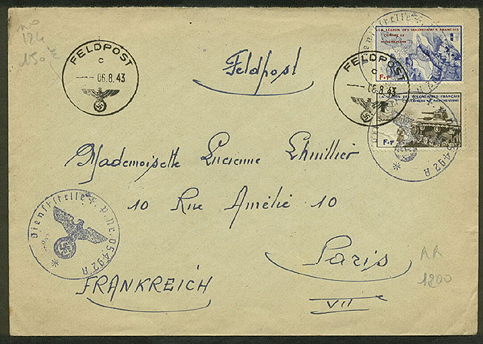
| Grenadier Regiment 638
In January 1944, the LVF was sent to the Russian front and was
engaged in anti-partisan operations. A reconstituted 2nd battalion
was added, and by the end of the year the LVF was reunited as
a whole regiment.
| 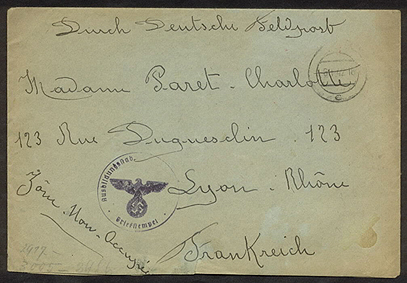
Interesting feldpost cover with written annotation indicating non-occupied zone. The reverse shows senders FPN 05492E (3rd Battalion). The cover has sealing tape and censorship markings. This cover came with an enclosed letter, which has been translated. It tells a bit on how these foreign volunteers felt about the issues of their time.
| 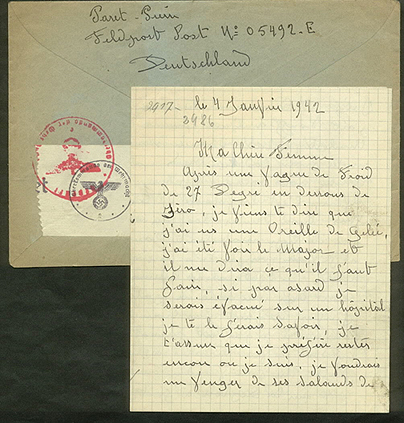
The content of the letter saids the following:
"My dear wife"
| 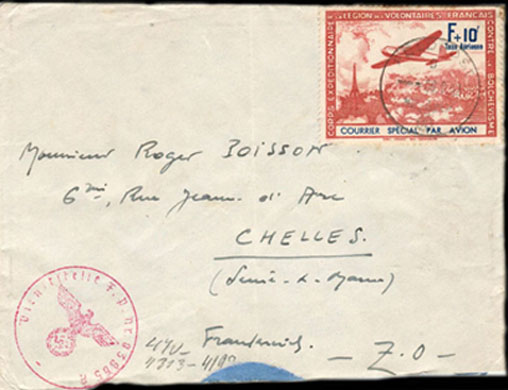
Interesting LVF feldpost mailed by Captain Poisson FPN 03865 1st battalion. From July 42 till December 43, the 1st battalion (Commandant Lacroix, Captain Poisson, Commandant Simoni) is engaged at Borissov, Smolensk, Sirsch, Kotovo where 150 Legionnaires resist to 1,000 Soviet partisans on May 22, 43, and Murovo. 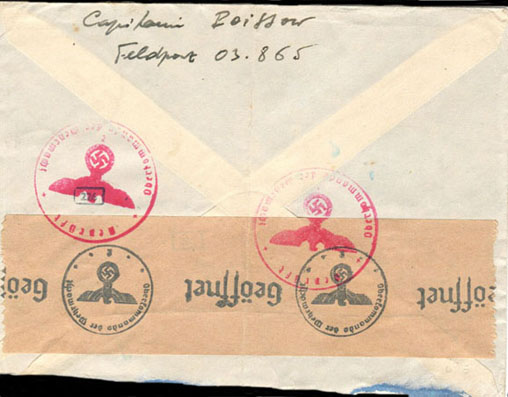
Reverse shows senders name and FPN. Cover has been censored.
| 8. Sturmbrigade Frankreich By the 1 September 1944 the LVF was disbanded and 1200 of its members volunteered for service with the "8. Sturmbrigade Frankreich" of the Waffen-SS. On 18 July 1944 the "French SS Volunteer Assault Brigade" was pronounced combat-ready. The following Feldpost numbers were assigned: Staff Brigade------------- 47335 1st. Btl. (1-4 Co.) -------------- 41592(A-D) 2nd. Btl. (5-8 Co.)-------------- 35411(A-D) 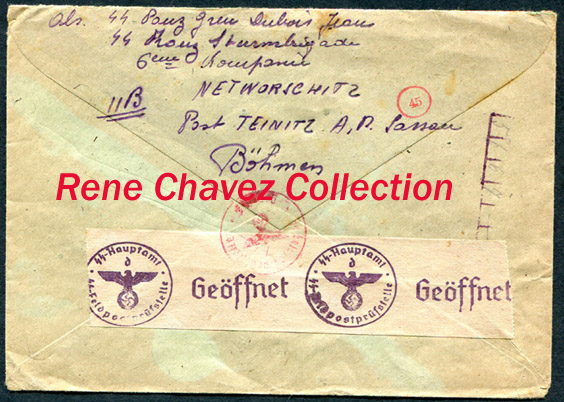
Very rare SS Feldpost cover mailed in the spring of 1944 by SS French volunteer who was attached to the 8th Sturmbrigade. Volunteer was in SS military training facility (SS Truppen übungplatz Böhmen) located in the Czech village of "Networschitz" (German) now known as "Netvořice" (Czech ). Cover was mailed to Amiens, France. Cover shows a SS sealing tape with a red censor postmark. 
Another rare SS Sturmbrigade feldpost mailed from the SS training barracks in Wildflecken. Cover has nice Wildflecken circular roller cancel dated December 7, 1944 and a very rare French SS Sturmbrigade circular seal. In addition, has SS censored sealing tape.
| 33. Waffen-Grenadier der SS Division Charlemagne
In September 1944 the assault brigade and the remaining members
of LVF were reorganized to form the French "33. Waffen-Grenadier
der SS Division Charlemagne." This division was supplemented
by French volunteers from the German Navy. The members of this
division, which was actually only a brigade in strength, came
from the following sources:
|
French NSKK
The French section of the NSKK began shortly after the German occupation of France in 1940, though the section was not officially recognized until July 1942. The main office was in Paris, but recruitment took place across France. 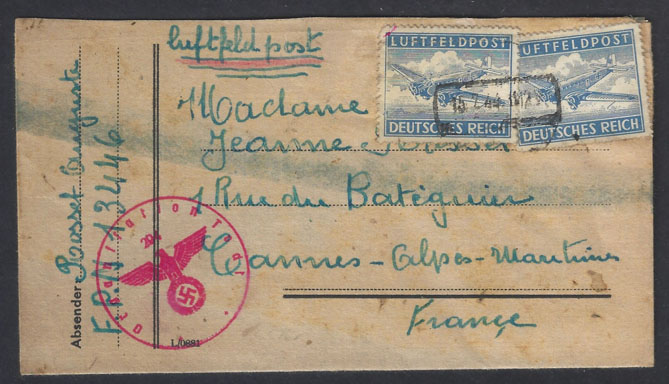
July 15, 1944, NSKK Luftfeldpost censored cover mailed by a French volunteer, FPN 13446 - NSKK Transportaion, 6th Co.
Besides the above volunteers, new recruits were still being
incorporated into the division. The command for the new division
was given to a German SS-General Krukenberg. By middle of February
1945, the division was ordered to join Army Group Vistula. This
sector lay about 100Kms southwest of Danzig and contained the
9th, 11th and 2nd German Armies under the command of General
Heinrici. This Army Group was used to stem the Russian advance
into Pomerania. German general staff---------------------------- 47335 Inspectorate of the French Waffen-SS------ 55448 57 SS Rgt. Staff Co., Anti-tank Co.--------- 66641 1st. Btl. (1-4 Co.) ------------------------- 41592(A-D) 2nd. Btl. (5-8 Co.)------------------------- 35411(A-D) Waffen-Grenadier Rgt. SS-58------------- 02951* 1st. Btl. (1-4 Co.) ---------------------- 03865(A-D)* 2nd. Btl. (5-8 Co.)----------------------- 05492(A-D)* 
Rare SS-Feldpost cover mailed in December 1944 by a member of the
"Brigade der SS Charlemagne,"
who was in training at the SS-Barracks in Wildflecken. The cover was addressed to a girl
in Speyer, Germany.
Waffen-Artillery Co. 33---------------------- 00290
SS Engineer Co. 33--------------------------- 64680
SS Anti-tank Co. 33-------------------------- 66885
SS Signals Co. 33------------------------------ 14309
SS Reserve & Training Co. 33-------------- 46795
SS Marsch Bn. "Greifenberg"------------- 65920
SS Medical Co. ------------------------------- 66453
SS Veterinary Co. --------------------------- 64921
SS Field Police 57------------------------------ 06953
SS Repair shop platoon-------------------- 13630
Field post office 57---------------------------- 11498
Note: (*)
Indicates unit transferred from Franz. Gren. Rgt. 638. Waffen-Grenadier Rgt. SS-58-------------09187 1st. Btl. (1-4 Co.) --------------------------
39630(A-D) 2nd. Btl. (5-8 Co.)--------------------------
19440(A-D) 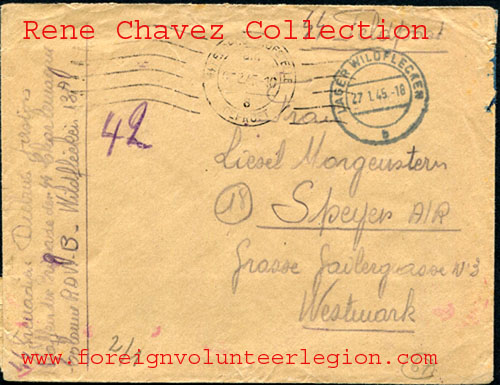
Here is another
Rare SS-Feldpost cover mailed in January 27, 1945 by the same Waffen-SS French volunteer of the
"Brigade der SS Charlemagne,"
who was in training at the SS-Barracks in Wildflecken. The cover was addressed to a girl
in Speyer, Germany. Note:The division post office (FPA SS-33) used
Kenn 565 from February to May 1945. | |||
[ Front Page ] [ Top] [Previous Page [ Next Page]